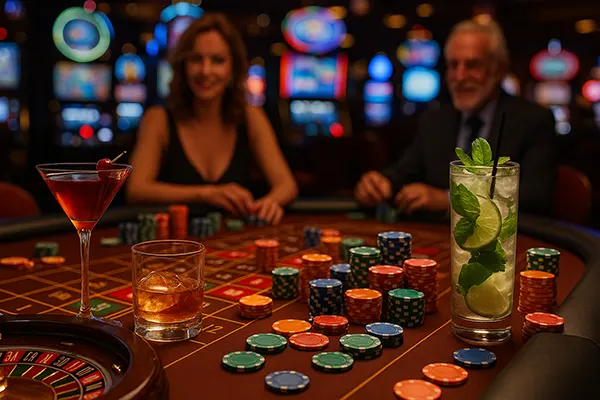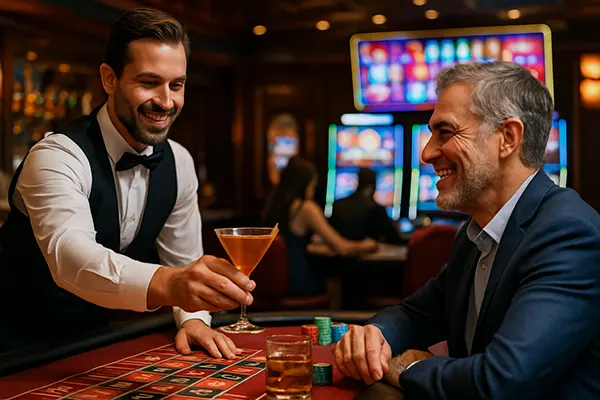
The Role of Alcohol in Casino Design: How Drinks Influence Atmosphere and Client Spending
In the carefully choreographed environment of a land-based casino, every detail is intentional—from lighting and music to air conditioning and, crucially, alcohol. Alcoholic beverages are not merely a complimentary service; they serve a strategic purpose in shaping customer behaviour, prolonging visits, and increasing expenditure. In June 2025, understanding how alcohol is utilised in casino design remains essential for assessing both its commercial and psychological implications.
Creating the Ideal Ambience: Alcohol as a Design Element
Alcohol plays a nuanced role in enhancing the overall ambience of a casino. It is seamlessly integrated into the spatial design, with elegant bar areas positioned for visibility and convenience, inviting guests to linger and socialise. The presence of alcohol signals leisure and indulgence, reinforcing the recreational nature of the casino environment.
Interior designers and behavioural consultants often collaborate to ensure alcohol-serving zones are both aesthetically appealing and functional. High-end materials, ambient lighting, and acoustic dampening are used to make these areas welcoming yet discrete, encouraging a relaxed mood without distracting from gaming floors.
From a sensory perspective, the availability of drinks complements the multi-sensory stimulation common in casinos. When consumed moderately, alcohol can enhance music appreciation and visual stimuli, heightening emotional arousal, which in turn may lead to more confident, less inhibited decision-making at tables or slots.
Strategic Placement and Timing of Beverage Service
Many casinos employ strategically placed roving cocktail servers rather than stationary bars alone. This ensures that players do not have to leave their tables or machines to obtain a drink, keeping them engaged and stationary—two key metrics in customer retention. In venues like Las Vegas or Monte Carlo, these practices are optimised to maintain player flow and momentum.
Timing also plays a significant role. Complimentary drinks are typically served more frequently during peak hours and in high-roller sections, reinforcing a sense of exclusivity and reward. These targeted tactics are supported by customer data and behavioural tracking systems that monitor play duration and betting amounts.
Additionally, in newer European and Asian casinos, mixology programs have been elevated to a form of experiential luxury. Signature cocktails tailored to the casino’s theme are offered as part of a curated experience, deepening brand identity and customer satisfaction.
Influence on Customer Spending Behaviour
Scientific research consistently shows a link between moderate alcohol consumption and increased spending behaviour. This is due to reduced inhibition, impaired risk assessment, and elevated confidence—all factors that can lead players to place larger or more frequent bets. Casinos have long understood this psychological trigger and utilise it as a revenue-enhancing tool.
A study published in 2023 by the International Journal of Hospitality Management found that patrons who consumed at least one alcoholic drink during a gaming session spent, on average, 18–24% more than those who remained sober. This finding aligns with similar data collected in large gaming markets such as the United States, the United Kingdom, and Macau.
However, responsible casinos take care not to cross the line into unethical manipulation. Most reputable venues implement drink limits or require players to maintain active gaming status to continue receiving complimentary beverages. This ensures that alcohol is used as a supportive feature, not a coercive one.
Customer Segmentation and Alcohol Policies
High-value customers are often treated differently when it comes to alcohol service. VIP lounges and private gaming rooms may offer top-shelf liquor, wine pairings, and even personal bartenders. These perks are designed to encourage loyalty and cultivate a sense of exclusivity, further increasing a player’s likelihood of repeat visits and high-volume play.
In contrast, many casinos targeting younger or health-conscious demographics have begun offering alcohol-free cocktail alternatives that replicate the social aspect without impairing judgment. This approach caters to changing attitudes among Millennials and Gen Z toward wellness and moderation.
Some jurisdictions have introduced stricter regulations on alcohol distribution within gaming establishments. As of June 2025, new licensing policies in parts of Australia and Canada limit complimentary drink offerings, aiming to curb problem gambling and excessive intoxication. These policies reflect an industry-wide shift toward responsible operation.

Alcohol, Atmosphere and Player Psychology
Alcohol influences not just physical space but also psychological perception. It plays a subtle but powerful role in altering time awareness and emotional state—two essential factors in casino psychology. Players under the influence may lose track of time more easily, extending their stay and increasing the potential for higher spending.
Many gaming venues enhance this effect by removing clocks and natural light, combining spatial design with alcohol-induced disorientation. This results in a self-reinforcing loop: longer stays, more spending, and increased drink consumption. These tactics, while commercially effective, have drawn scrutiny from public health experts advocating for ethical design standards.
Despite the benefits for revenue, there is a growing push to balance atmospheric design with player protection. As part of industry best practices, more casinos now train staff to recognise signs of overconsumption and encourage voluntary breaks or self-exclusion measures if necessary.
Ethical Considerations and Industry Trends
As awareness grows around the ethical dimensions of casino design, many operators are re-evaluating the role of alcohol in their establishments. Some have adopted harm-reduction approaches, such as limiting drink strengths, offering free bottled water, and integrating wellness lounges into their layouts.
Tech-enabled solutions are also emerging. For example, facial recognition and player tracking systems can now alert staff if a patron shows patterns of behaviour consistent with alcohol misuse or gaming addiction. These proactive interventions align with regulatory trends and corporate social responsibility standards.
Ultimately, the role of alcohol in casino design is evolving. What was once a blunt instrument of influence is becoming a more refined, regulated, and consciously deployed element. In this delicate balance of ambience, psychology, and profit, the emphasis is shifting from maximisation to moderation.
